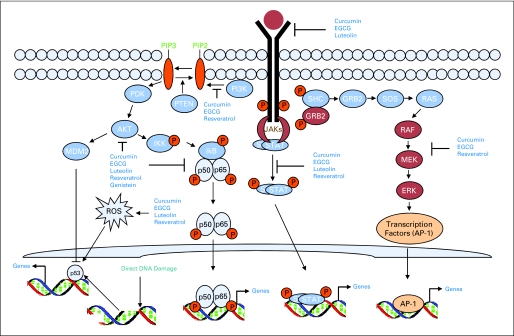Fig 2.
Molecular targets of natural chemopreventive agents. The cell signaling pathways activated by natural dietary agents are numerous and different for different agents. Multiple growth factor receptors (epidermal growth factor receptor, insulin-like growth factor 1 receptor, fibroblast growth factor, platelet-derived growth factor receptor) are activated at the cell surface in tumorigenesis. Activation of these receptors activates several downstream signaling pathways. Among these pathways, the Ras-MAPK (such as ERK and JNK) pathways, the JAK-STAT pathways, the PI3K-AKT pathways and the NF-κB pathways are important and are the targets of natural chemopreventive agents. Some natural agents inhibit the receptors at the cell surface either by dephosphorylating them or by inducing their degradation, which ultimately modulate the downstream signaling pathways important for proliferation, angiogenesis, and apoptosis. Inhibition of AKT and ERK signaling by natural agents is quite common, although in many cases this inhibition is the result of growth factor receptor inhibition. Inhibition of NF-κB signaling pathway by interfering with multiple targets of signaling is another common target of natural agents. Many natural compounds generate reactive oxygen species (ROS), which activate p53 family members and induce cell cycle arrest and apoptosis. EGCG, epigallocatechin-3-gallate; ERK, extracellular signal–regulated kinase.

